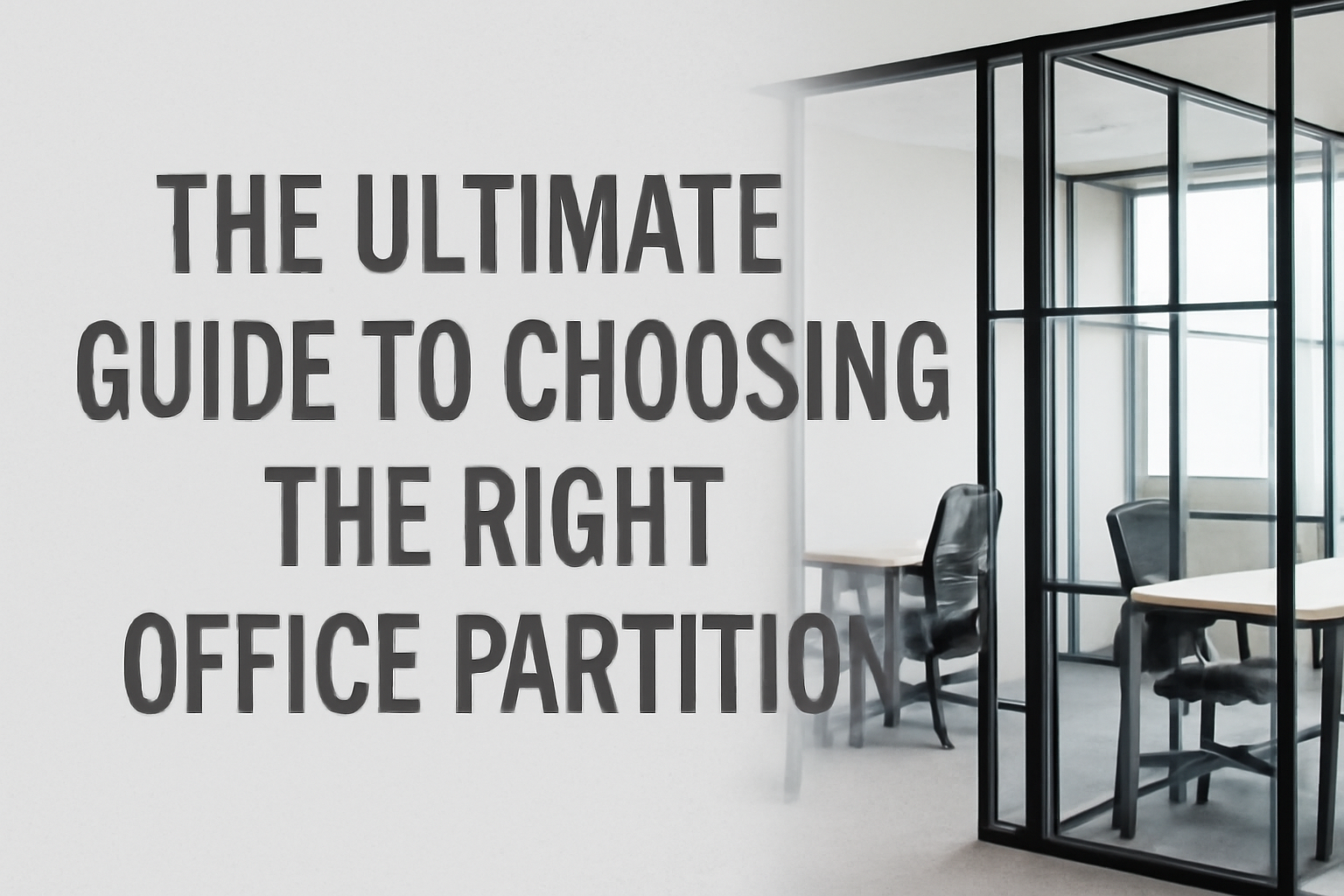The Ultimate Guide to Choosing the Right Office Partition

In today’s modern workspaces, creating an environment that balances privacy, functionality, and aesthetics is crucial for promoting productivity and employee well-being. One of the most effective ways to achieve this balance is by installing office partitions. These partitions can transform an open-plan office into a more structured and private space. But choosing the right office partition can be overwhelming given the variety of materials, designs, and configurations available.
This guide will walk you through the key considerations for selecting the perfect office partition. Whether you’re redesigning a small office or organizing a large corporate space, understanding your needs and preferences is essential to making an informed decision. From space optimization to style preferences, this article covers it all.
1. Identify Your Needs and Objectives
Before diving into the details of different types of office partitions, it’s important to clearly define your goals. Why are you installing office partitions in the first place? Your needs will heavily influence the type of partition you choose. Here are a few common reasons businesses opt for office partitions:
- Privacy: If your work environment requires confidential conversations or personal space, partitions provide a valuable solution. Employees need to focus on their tasks without distractions.
- Space division: In larger offices, partitions help segment different work areas, such as cubicles, meeting rooms, and lounges.
- Noise reduction: For open-plan offices, noise can be a major problem. Partitions made from soundproof materials can effectively reduce distractions and create a quieter work environment.
- Aesthetic appeal: Sometimes, partitions are chosen simply for their visual appeal to enhance the look of the office, making it feel more modern, structured, or welcoming.
Understanding your needs will help you narrow down the different types of office partitions that can serve your purpose. For example, if privacy is a top priority, you might lean towards high partitions with soundproofing capabilities.
2. Consider the Type of Partition
There are several types of office partitions, each with unique features that make them suitable for different purposes. Below are some of the most common types:
Freestanding Partitions
These partitions stand independently without requiring mounting or installation into the office’s walls. They’re versatile and can be easily relocated, which makes them perfect for businesses that need flexible space arrangements. You can use freestanding partitions to create temporary workstations or meeting areas. They are especially ideal for offices that constantly need to reconfigure their layout.
Modular Partitions
Modular partitions are made up of smaller, individual panels that can be combined to create larger structures. This modularity makes them highly customizable, allowing you to adjust the height, width, and layout of the partitions as per your needs. This flexibility is especially useful in growing companies that may need to expand or rearrange their office setup over time.
Glass Partitions
For a sleek and modern aesthetic, glass partitions are a popular choice. These partitions allow for an open, airy feel while still providing separation between workstations. They are ideal for offices that want to maintain visibility and encourage communication while still creating private spaces. Additionally, glass partitions can be frosted or etched for added privacy.
Acoustic Partitions
Acoustic partitions are designed to reduce sound and minimize distractions in noisy work environments. They are often made from sound-absorbing materials and are ideal for offices where phone calls, meetings, or confidential discussions need to take place without interference from external noise.
Wooden Partitions
Wooden partitions provide a warm, classic look to any office space. They can range from solid wood to veneer finishes and are often used to create a sophisticated and inviting environment. Wooden partitions are also effective at providing privacy and sound insulation.
3. Material Selection for Office Partitions
When choosing the right office partition, the material is one of the most important aspects to consider. The material impacts both the functionality and the visual appeal of the partition. پارتیشن اداری can be made from various materials, including:
- Glass: A popular choice for its modern look and transparency. It creates a sense of openness while still offering division between spaces. Glass is ideal for offices that want to promote a feeling of collaboration while maintaining some privacy.
- Wood: Wood is a timeless material that offers warmth and style to an office. It’s sturdy and provides a solid visual barrier, making it an excellent choice for private offices or conference rooms. It’s also good for sound insulation, creating a quieter workspace.
- Metal: Metal partitions are often used in industrial-style offices and are highly durable. They provide a clean, sleek look and are easy to maintain. They’re also great for dividing large office spaces, offering both strength and flexibility.
- Fabric and Upholstered Partitions: Fabric partitions offer an affordable option for creating semi-private workspaces. These partitions can be customized with different colors and textures to match the office’s decor. They can also be soundproofed, which makes them a great choice for noisy environments.
- Plastic or Acrylic: For a lightweight and cost-effective solution, plastic or acrylic partitions are available. These materials are durable and can be made to look modern and stylish. They can be transparent or opaque, depending on the amount of privacy needed.
Each material has its pros and cons, so it’s important to weigh your options carefully. For instance, if you want a modern, sophisticated look with an emphasis on natural light, glass partitions might be the best option. If you’re concerned about sound, acoustic partitions made of fabric or foam might serve your needs better.
4. Understanding the Space Layout
The layout of your office plays a huge role in how effective your partitions will be. The design of the office should guide your partition choices, so it’s essential to consider the overall layout before making a decision.
- Open-plan offices: These types of offices benefit from partitions that can create individual workstations while still allowing the flow of light and communication. Modular partitions or glass panels work well here, as they create division without making the space feel cramped.
- Private offices: If you need more defined and private areas, taller, more solid partitions might be a better choice. Wood or high acoustic partitions are ideal for this kind of setup as they provide both privacy and noise reduction.
- Meeting rooms and conference spaces: For these areas, you may want partitions that can either be easily installed or removed. Glass partitions or modular wall systems are great for creating flexible spaces for meetings while maintaining an open feel.
Additionally, consider the size and shape of your office when choosing partitions. Larger spaces may need taller or more complex partitioning solutions, while smaller offices may benefit from simple and less intrusive designs.
5. Budget Considerations
Finally, one of the most important factors in choosing the right office partition is your budget. Office partitions come in a wide range of price points, depending on the material, design, and customization options. Before you begin shopping, establish a budget and ensure that the partitions you choose align with your financial constraints.
While it’s tempting to go for high-end, luxurious partitions, it’s essential to balance quality with cost. There are many affordable options that still provide great functionality and design. Modular systems and fabric partitions, for example, are often more cost-effective but can still deliver excellent results. On the other hand, custom-made partitions or high-end materials like glass or solid wood will come with a higher price tag, but they may be worth the investment for their durability and aesthetics.
When budgeting, remember to factor in the costs for installation, maintenance, and potential future upgrades. Modular systems are often the most cost-effective long-term option because they can be easily rearranged or expanded to meet changing needs.
Conclusion
Choosing the right office partition is an important decision that can greatly impact the functionality, privacy, and aesthetics of your workspace. From identifying your needs and considering various partition types to selecting the appropriate material and understanding your office layout, each step plays a crucial role in creating the ideal office environment.
Incorporating office partitions allows you to tailor your workspace to fit both your current needs and future growth. If you’re ready to start your office transformation, visit https://partitionsazeh.com/ for expert guidance and options to fit every workspace.



